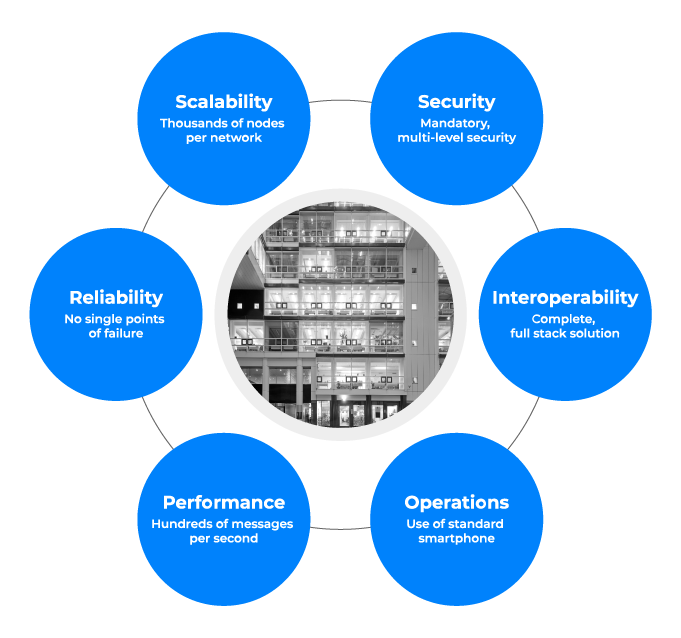For years, there has been a widely held opinion that when it comes to signal dependability, wireless networks cannot compete with a wired infrastructure. While they offer many advantages, traditionally, they have not been able to offer the reliability needed by enterprise and industrial spaces, especially commercial lighting. However, recent advancements in Bluetooth® technology are changing the way networked lighting control systems are deployed.
Bluetooth® Mesh networking has emerged as the scalable and reliable solution for commercial lighting control that can turn the promise of data-driven smart building services into reality. Deployed in offices, retail, healthcare, factories, and other commercial facilities, Bluetooth networked lighting control systems deliver a combination of energy savings, an enhanced occupant experience, and more efficient building operations.
“Energy savings is an important aspect of lighting,” said Stephen Zhou, vice president at McWong International. “Adding a Bluetooth Mesh lighting control system will further save energy on top of energy efficient LED. The non-lighting benefit of an existing Bluetooth Mesh sensor infrastructure will play an important role for future building automation.”

No Wires Required
This shift from wired to wireless solutions for networked lighting control is being driven by three main advantages of wireless systems: lower cost, greater design flexibility, and future extensibility.
Without the need to pull control wires, wireless networked lighting controls offer significantly lower deployment costs. Decreased labor and material costs, minimum disruption to business operations during installation, and reduced ongoing maintenance costs combine to bring substantial savings to building owners and managers, particularly in retrofits.
Wireless systems allow for the placement of equipment where distance restrictions or accessibility would make a wired solution impractical, if not impossible. In addition, wires are fixed, but spaces and layouts change, and lighting control systems must adapt with them. Wireless systems are more easily reconfigurable and provide superior flexibility compared with wired offerings.
The ideal networked lighting control system is often one that can start small and then scale, in both functionality and size. Once deployed, wireless systems are far more extensible than wired counterparts and can more easily add advanced controls and expand to meet changing business needs and occupant requirements.
Bluetooth Technology Lights the Way
Advanced commercial lighting control is one use case that has rapidly embraced Bluetooth® Mesh networking. Bluetooth Mesh enables the creation of large-scale networked lighting control solutions and is ideally suited for control, monitoring, and automation systems where hundreds or thousands of devices need to communicate with one another. Designed to meet the strict requirements of commercial and industrial spaces, Bluetooth Mesh networking delivers the performance, reliability, and security needed for networked lighting control in these demanding environments.

A Cost-Effective Decentralized Architecture
The cost of deploying, or even piloting, legacy networked lighting control systems has limited their adoption. Bluetooth® Mesh removes the need for centralized controllers, lowering the cost of componentry and reducing upfront labor and installation expenses, allowing designers and specifiers to quickly deliver value to building owners and end users.
Direct Mobile Device Provisioning
With Bluetooth® technology native in 100% of smartphones and tablets, system integrators and installers can use simple, user-friendly, commissioning apps that communicate directly with nodes on the network, eliminating the need for specialized engineering expertise as well as internet access and cloud platforms to support installation and operation of the system.
“More and more companies are becoming Bluetooth Mesh qualified,” said Dennis Fullin, Senior Product Marketing Manager at OSRAM. “In several projects, I see different component providers. The Bluetooth SIG is offering more and more standard commands that are implemented continuously.”
Best-In-Class Scale, Performance & Reliability
Bluetooth® Mesh networking was specifically designed with large-scale networked lighting control implementations in mind. Three key features help separate the scale, performance, and reliability of Bluetooth Mesh from other wireless lighting control technologies and provide the resiliency needed by installers, building managers, and end users in commercial installations.
- A decentralized control architecture distributes intelligence to all end devices, eliminating single points of failure to prevent system-level outages
- A unique publish/subscribe message addressing approach significantly lowers messaging traffic on the network, leading to greater network scale and performance
- A managed flood message relay approach enables lighting networks to scale to thousands of nodes while maintaining high performance and reliability
“The base of Bluetooth Mesh is the distributed intelligence,” said Fullin. “If the communication is corrupted, the system continues to work until communication is re-established.”
Additional Benefits Beyond Illumination
“The non-lighting benefit of an existing Bluetooth Mesh sensor infrastructure will play an important role for future building automation,” said Zhou. The same Bluetooth® radio embedded in lighting control devices can also be used to implement advanced building services, such as indoor navigation and asset tracking, enabling networked lighting control systems to shift from a single-function solution to a platform for data-driven smart building services that bring benefits far beyond illumination.